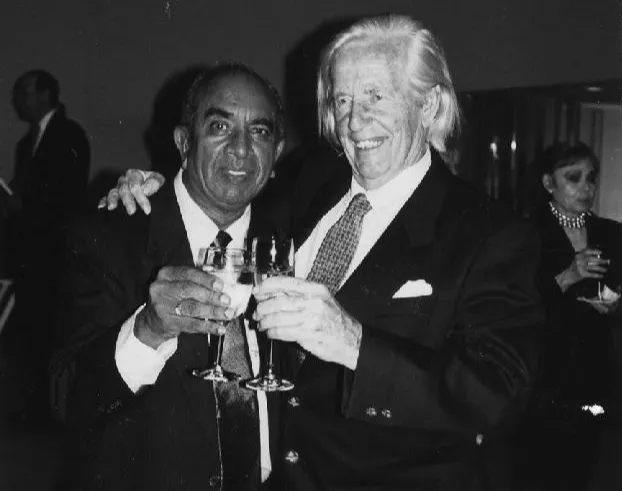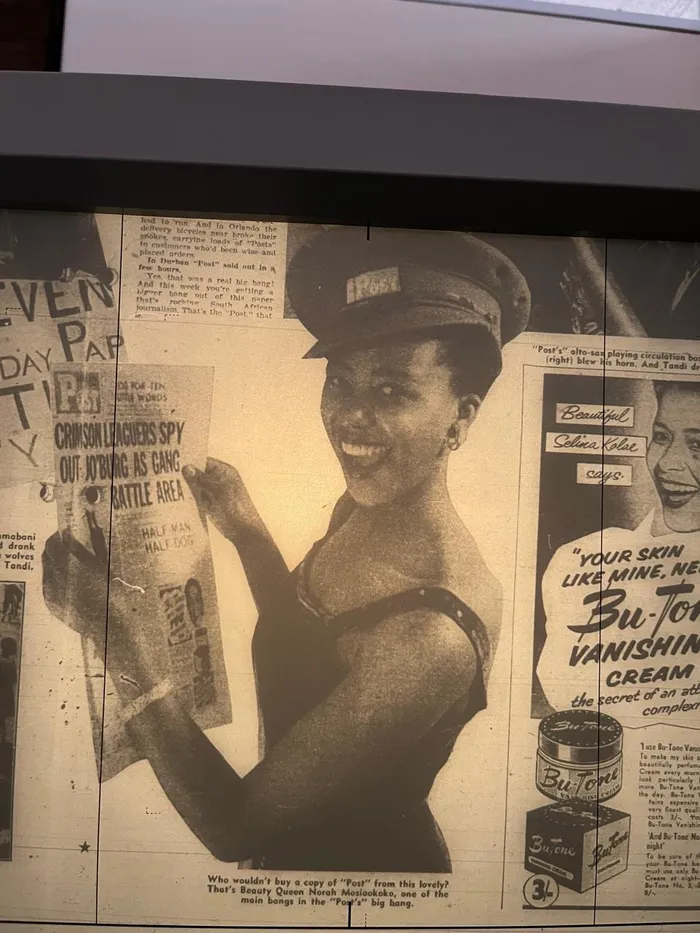Golden City Evolution into POST
Remembering the past

Gopal Naransamy and Jim Bailey, founder publisher of Drum. This photograph was taken in New York in 1996 at the opening of the Guggenheim exhibition 'In/sight African Photographers, 1940 to the Present'. Three of Gopal Naransamy's pictures from the 1950s had been selected for this exhibition which featured 30 African photographers. (Unknown photographer, 1996.)
Image: researchgate.net/ Creative Commons
WHEN the Golden City Post burst onto the newsstands on Sunday, March 13, 1955, it brought a wicked sparkle to the face of South African journalism.
The racy and pioneering tabloid targeting mainly South Africa's growing Indian community was the brainchild of the eccentric media entrepreneur, Jim Bailey. He also founded Drum magazine in 1951 which carried the stories of black South Africans to the rest of the African continent. Bailey was astute enough to read the business environment that the white market was saturated while black readers offered fresh prospects for expansion.
The paper was initially produced in Johannesburg’s Drum's offices by Drum staffers under the editorship of Cecile Eprile.
The Golden City Post filled a hunger for news about the lives of ordinary and not so ordinary people that was distinct from the traditional news media. The paper hit the streets amid the growing tensions of apartheid. Journalists tangled with political issues poking fun at absurdities like the Immorality and Mixed Marriages acts.
Photographers found themselves in the unlikeliest of places capturing images that meticulously documented the social and political history of the period.
The POST quickly became the best-selling tabloid of its kind.

1950s beauty queen Norah Moslookoko showed off the first edition of Golden City Post to hit the streets.
Image: Golden City Post Archives
In an interview with Stefanie Lotter, an internationally-renowned photographer, Gopal Naransamy captured the scene at one of freedom Struggle hero, Joe Slovo’s parties: "As usual I was clicking at the couples on the dance floor. The large dining room and lounge improvised with the connecting doors widely open, resembled an original makeshift dance floor accompanied by settees and padded sofas to make the walls more relaxing. There was plenty of liquor and beer, and for some of the ladies, tea and biscuits.
"The music and the dance was in full swing when about 10.30pm or 11pm, we heard the crash of broken glass and saw white cops climbing through the window, clad in khaki uniform and batons swinging in their hands, trying to stop the mixed couples from dancing. The large table in the lounge was a high view for one of the cops who jumped on to the table, boots and all. He did not have a gun in his hand, but a camera which looked like a 35mm to me.
"While he was photographing the mixed couples who were deliberately hugging one another posing for the picture, I grabbed the opportunity to photograph the cop in action."
Among Naransamy’s counterparts were Alf Kumalo who was taken on by the Golden City Post as a full-time photographer in 1960. Henry “Mr Drum” Nxumalo was on the staff of the POST since its inception. Some Drum staffers moved to the POST permanently while others were on temporary loan. The opposite was true for Bloke Modisane who joined Drum via the POST.
The exiled writer and activist from Pietermaritzburg, Bessie Head, was employed as a trainee journalist on the POST. Juby Mayet had her own column with the Golden City Post by the later 1960s. Trouble with the apartheid authorities was never far away. GR Naidoo and Can Themba were among those who risked their lives getting stories.
Christopher Merret noted that in 1958, Golden City Post reporters were assaulted while the police looked on and did nothing. At one point, Naidoo was arrested and detained without trial for 97 days. Many of the most courageous voices in the media were either silenced through banning orders, imprisoned or forced into exile. The illustrious Nat Nakasa died in New York in 1965. In spite of the harassment, those that remained free persevered in bringing the news to the people.The readership like today’s POST, extended well beyond an Indian audience. It became a must-read everywhere from Sophiatown to Fietas, to Marabastad in the old Transvaal.
Circulation figures especially in Durban’s Grey Street complex, Cato Manor and Clairwood reflected a strong community interest in the exciting paper. When Drum faced financial pressure with the apartheid state hounding Bailey in the courts as well as his massive investment in new printing technology, the magazine was transformed into a smaller monthly insert in the Golden City Post in 1965.
The 1960s were a time of political ferment around the globe. In March of 1968, students at Nanterre University in France started protests against university conditions and broader social issues which quickly spread to the Sorbonne in central Paris. This sparked what came to be known as the Paris Revolt with nationwide strikes and barricades in major cities.
Radical voices began to grow in the South African student movement too with the emergence of the South African Students' Organisation (Saso) led by Steve Biko, Barney Pityana and others before the end of that year. Later POST editor, Dennis Pather, was part of that radical Black Consciousness generation. His first job was as a cub reporter on the Golden City Post.
The end of March 1968 also saw Drum re-emerge in its original form. the Golden City Post declared: "Welcome back, Drum! That's POST 's cry this week - and it will be the cry of countless thousands throughout the country next week when Drum, Africa's greatest magazine, goes back on sale in its old monthly form."
The new and "improved" version of Drum was edited by DJ Garner, assisted by Naidoo. In his book, Who Killed Mr Drum?, author Sylvester Stein revealed that Golden City Post’s founding editor, Eprile, was a year later identified as a paid spy of the Central Intelligence Agency (CIA) in the United States. The intrigues were hardly surprising. Journalists were constantly being pressured by intelligence agencies both locally and from abroad to supply information about what was going on in anti-apartheid political circles.
While the core of the profession paid a hefty price for standing on principle, suspicions linger that there might have been others cajoled by the carrot of easy money or threatened into submission.
Other than the constant harassment by the apartheid state, Bailey also believed that his competitors, notably the Argus Group, were out to destroy him by undercutting the Golden City Post’s advertising rates and manipulating circulation through its control of the CNA distribution agency.
By the end of 1971, an embattled Bailey was forced into selling at a fraction of the paper’s value to the Argus Group. On November 3, 1971, a headline lamenting "The Last Post" reported: “In a shock announcement, POST's chairman, Mr Jim Bailey, told his staff the paper would close immediately … Stunned staffers abandoned stories and pages set up for tomorrow's edition. They were told some staff would be taken over by Drum magazine, others by the Argus company, but some would be fired …”
While an era was ending for the Golden City Post, another was just beginning as Post Natal. Later editor Brijlall Ramguthee told researcher Deseni Sooben that POST changed its “racy, sexy Golden City Post (Natal) image” to become far more family oriented. She noted further that as the 1970s unfolded, “one of the main strategies of POST’s management was to eliminate the image POST had acquired, that of publishing pictures of attractive young women on page three”.
Another former editor, Pather, recounted in a commemorative publication on the paper’s golden anniversary that he joined the Golden City Post “back in the days when scantily-dressed starlets, super soccer stars and scandalous sinners ruled the headlines. Dad chose to read the racy tabloid in the privacy of his office, mum nicked hers from a neighbour for a furtive flip-through while the kids giggled over pictures of bare-breasted belles under their classroom desk covers.”
Among the team putting the paper together in the 1970s were Ed Booth, Tom McQuaig, Cheryl Carter, Ami Nanckchand, Sudha Garbharran, Kanabathy "KG" Moodley, Marlan Padayachee, Malcom Dunkeld, Gary Brennan, Jeff King, Ismail "IA" Khan, Ranjith Kally and Bobby Harrypersad.
The POST navigated censorship and political pressure by centering on community stories while subtly critiquing racial injustices. Post-apartheid, it shifted toward broader KwaZulu-Natal coverage, including politics, entertainment and cultural milestones for the Indian diaspora. By the 2010s, it had a quarterly net sales average of around 44 000 copies and an average issue readership of over 340 000, distributed across Gauteng, KZN, Free State and Eastern Cape.
In 2025, marking its 70th anniversary, the POST remains active under Independent Media, with initiatives like the free weekly POST Plus supplement delivered to 80 000 homes in Indian-majority areas. Its digital presence is hosted on IOL.co.za/thepost, emphasising community upliftment.
Related Topics: